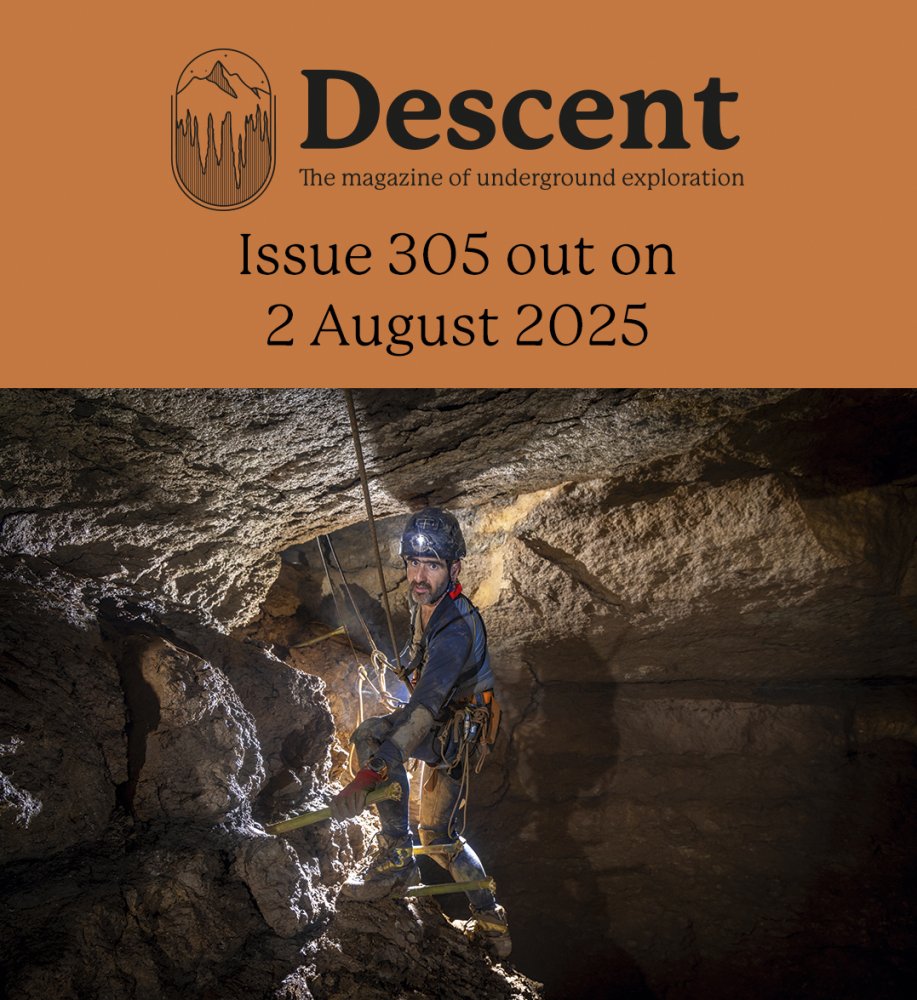You are using an out of date browser. It may not display this or other websites correctly.
You should upgrade or use an alternative browser.
You should upgrade or use an alternative browser.
Redhouse Lane Swallet Update
- Thread starter Tritim230
- Start date
PeteHall
Moderator
Better than the psychological abuse I'm getting, watching the cave grow and unable to get down for another couple of weeks!It is bodily abuse on a grand scale.
PeteHall
Moderator
But that will spoil all the fun of the entrance series 
Joking aside, it's going to be a hell ofa though trip! Can you imagine doing a "grand tour" of the Slaughter Stream System. In Wet Sink, around the loop, through Redhouse, down to Moria, along the (as yet undiscovered) link to Chocolate River, out at Symonds Yat. A brief walk to Big Sink, then through to WOTSTW and back through the high level stuff before exiting via Redhouse!
Joking aside, it's going to be a hell ofa though trip! Can you imagine doing a "grand tour" of the Slaughter Stream System. In Wet Sink, around the loop, through Redhouse, down to Moria, along the (as yet undiscovered) link to Chocolate River, out at Symonds Yat. A brief walk to Big Sink, then through to WOTSTW and back through the high level stuff before exiting via Redhouse!
PeteHall
Moderator
In at Kiln Piece Hole! How could I forget that!In Wet Sink, around the loop...
Tritim230
Well-known member
An update from yesterday's trip.
From beyond the previous limit in the Chocolate River, we followed a crawl to a high rift passage for ~20m, before it 'Ghar Parau'ed'. There is still a very strong draught, and a narrow on-going rift that can be progressed with the aid of a lump hammer, plus a sketchy climb above the current level reached upwards.
We continued surveying passages identified last week, including a desperate climb down a 45 degree rift to a pool, ongoing but needs aid to cross the rift; and a long inlet series of fine crease limestone passage, but mainly filled with cryogenic mud above calcite rafts, necessitating hands and knees crawling along the whole length.
Newly surveyed passage, 237m, somewhat disappointing compared with the previous weeks, but.....
Ian, who has a habit of descending promising looking rifts (qv the Mines of Moria (Descent 302)), found after a very dodgy climb another major trunk route passage. We were at the limit of our time, so left on-going and unsurveyed. However, it was videoed....
Also, Falkland and Alex did a lot of taping but ran out tape and pins after 400m used!
Back next week to push and survey if our battered and aching bodies allow.
From beyond the previous limit in the Chocolate River, we followed a crawl to a high rift passage for ~20m, before it 'Ghar Parau'ed'. There is still a very strong draught, and a narrow on-going rift that can be progressed with the aid of a lump hammer, plus a sketchy climb above the current level reached upwards.
We continued surveying passages identified last week, including a desperate climb down a 45 degree rift to a pool, ongoing but needs aid to cross the rift; and a long inlet series of fine crease limestone passage, but mainly filled with cryogenic mud above calcite rafts, necessitating hands and knees crawling along the whole length.
Newly surveyed passage, 237m, somewhat disappointing compared with the previous weeks, but.....
Ian, who has a habit of descending promising looking rifts (qv the Mines of Moria (Descent 302)), found after a very dodgy climb another major trunk route passage. We were at the limit of our time, so left on-going and unsurveyed. However, it was videoed....
Also, Falkland and Alex did a lot of taping but ran out tape and pins after 400m used!
Back next week to push and survey if our battered and aching bodies allow.
Adventure Traveller
Active member
Cantclimbtom
Well-known member
Maybe I'm a bit thick but how could that chocolate river pattern happen? I've seen exactly those shapes when mud has dried and shrunk in the air, but once water returns it usually resumes its ordinary non patterned muddiness
Edit: reading up on this (dessication cracks) it must be the result of many cycles of wetting and drying
Edit: reading up on this (dessication cracks) it must be the result of many cycles of wetting and drying
Last edited:
Tritim230
Well-known member
We are confused as well. As you say, mud cracks when it dries. It could be seasonal. We'll check in summer to verify this.
Even more confusing is the discovery of a major passage some 10m lower with no signs of water, but established calcite flows (as per Ian's latest video). We are still well above resurgence level though.
The history of the cave formation is highly complex and will make fine research for those qualified.
Even more confusing is the discovery of a major passage some 10m lower with no signs of water, but established calcite flows (as per Ian's latest video). We are still well above resurgence level though.
The history of the cave formation is highly complex and will make fine research for those qualified.
Limestone doesn't actually have a water table, as the passages are discrete entities, some of which may be overflow channels, but others will have been abandoned for lower options, whilst the impervious beds below are not flat surfaces - map on link only shows surface outcrops, with cross section to south of cave:
mrodoc
Well-known member
Cracks can remain in immersed mud. Sometimes they fill with other materials eg sand or halides. You can see this phenomenon at Salcombe Regis in Devon where Triassic Marl has veins of red gypsum in what is clearly sedimentary rock. In some places the veins are vertical but only short distances and I presume unless corrected these are cracks in the mud filled with halide that have subsequently dried out before the site was immersed again. Water can also carry sediment right over floor deposits as Snowy River in Fort Stanton Cave (New Mexico) remains pristine despite a stream flowing over it at fairly frequent intervals and that's 8+ miles long!
The Old Ruminator
Well-known member
Further to the last comment. Withyhill has ancient cracked mud in several off route areas. In time the cracks have filled with calcite. More cracked mud in Reservoir Hole and Agen Allwedd
Tritim230
Well-known member
Exploration Update. On Sunday 6th April 3 teams descended Redhouse to leave the glorious sunshine behind for 12 1/2 hours: 2 survey and 1 conservation.
The aims were to rig and descend the Consolation Climb and to explore and survey the passages beyond. Team 1 survey and the conservation team worked together in this section.
After the climb (12m), the passage was followed westbound, large and boulder strewn with lovely calcite coating on the walls and a section of cave pearls cemented in the rocks. We took it in turns to push into new passage. Suddenly from the front were gasps of elation, we discovered the "White Forest". A superbly decorated section around 150m long adorned with every formation type I can recall - cave pearls, flow stone, stalactites, stalagmites, straws, helictites, columns, curtains, and helictites on straws, gour pools, and mud gours. In one section, there was a row of 'Courtesans'. Without doubt the finest display of formations in the Forest and to rival Otter Hole, albeit on a smaller scale.
The passage continued with fewer formations but with lovely calcite flows in sections to a fine canyon which abruptly ended in a chamber with a pretty inlet cascading over gour pools. To the left was a small arch, through which blew a howling draught. Despite my best efforts of getting my head and one arm through, the chest and other arm failed to follow, but I could see a large chamber/passage going on. This point is only 120m horizontally and 30m vertically below Symonds Yat Swallet. Total surveyed length 408m, plus ~ 40m of tidying up earlier in the 'north passage' which included a fine rift that is within a metre of connecting with passage surveyed 3 weeks earlier.
Team 2 survey explored around the previously undescended pitch to the streamway, below Tiff's Treat. The pitch was rigged to 100m of large streamway, which then cascades down a further pitch into what looks like a major passage beyond.
One of the finest trips to the system to date, and that is saying something after the discovery of the Marble River last year.
The aims were to rig and descend the Consolation Climb and to explore and survey the passages beyond. Team 1 survey and the conservation team worked together in this section.
After the climb (12m), the passage was followed westbound, large and boulder strewn with lovely calcite coating on the walls and a section of cave pearls cemented in the rocks. We took it in turns to push into new passage. Suddenly from the front were gasps of elation, we discovered the "White Forest". A superbly decorated section around 150m long adorned with every formation type I can recall - cave pearls, flow stone, stalactites, stalagmites, straws, helictites, columns, curtains, and helictites on straws, gour pools, and mud gours. In one section, there was a row of 'Courtesans'. Without doubt the finest display of formations in the Forest and to rival Otter Hole, albeit on a smaller scale.
The passage continued with fewer formations but with lovely calcite flows in sections to a fine canyon which abruptly ended in a chamber with a pretty inlet cascading over gour pools. To the left was a small arch, through which blew a howling draught. Despite my best efforts of getting my head and one arm through, the chest and other arm failed to follow, but I could see a large chamber/passage going on. This point is only 120m horizontally and 30m vertically below Symonds Yat Swallet. Total surveyed length 408m, plus ~ 40m of tidying up earlier in the 'north passage' which included a fine rift that is within a metre of connecting with passage surveyed 3 weeks earlier.
Team 2 survey explored around the previously undescended pitch to the streamway, below Tiff's Treat. The pitch was rigged to 100m of large streamway, which then cascades down a further pitch into what looks like a major passage beyond.
One of the finest trips to the system to date, and that is saying something after the discovery of the Marble River last year.
Similar threads
- Replies
- 19
- Views
- 1K
- Replies
- 24
- Views
- 3K


